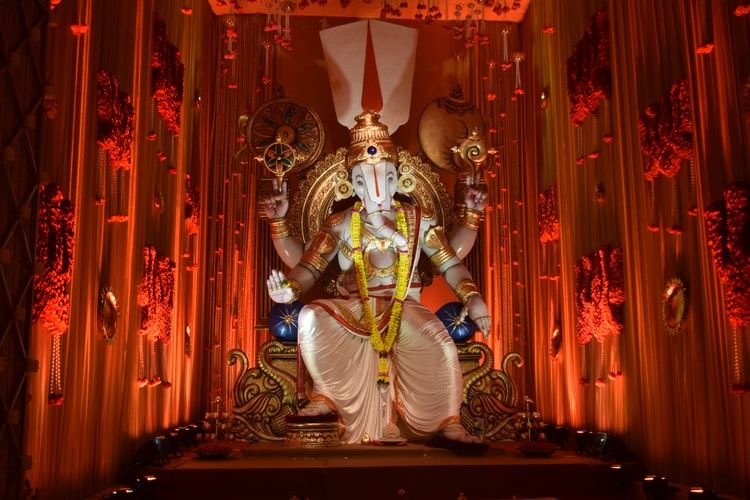Ganesh Chaturthi History
Ganesh Chaturthi, also known as Vinayaka Chaturthi, is a Hindu festival that celebrates the birth of Lord Ganesha, the elephant-headed god of wisdom, prosperity, and good fortune. It is one of the most widely celebrated festivals in India and by Hindus around the world.
The festival usually falls in the Hindu calendar month of Bhadrapada, which typically corresponds to August or September in the Gregorian calendar. The exact date varies each year depending on the lunar cycle.
During Ganesh Chaturthi, idols of Lord Ganesha are installed in homes, temples, and public places. These idols are worshipped with great devotion, and various rituals are performed. The festival typically lasts for ten days, with the culmination known as Ananta Chaturdashi.

On the last day, the idols are taken in a procession and immersed in a body of water, such as a river or the sea, symbolizing the departure of Lord Ganesha to his abode, Mount Kailash.
Ganesh Chaturthi is a time of joy, feasting, and cultural celebrations. It brings together families and communities, fostering a sense of unity and devotion towards Lord Ganesha. In recent years, there has been a growing emphasis on eco-friendly celebrations, encouraging the use of natural, biodegradable materials for making idols to reduce environmental impact.
Why we Celebrate ?
Ganesh Chaturthi is celebrated to honor and commemorate the birth of Lord Ganesha, who is one of the most revered deities in Hinduism. Lord Ganesha is known as the elephant-headed god of wisdom, prosperity, and good fortune. The celebration of Ganesh Chaturthi holds significant cultural, religious, and social importance for several reasons:
- Devotion to Lord Ganesha: Lord Ganesha is believed to be the remover of obstacles and the bestower of wisdom and success. Devotees seek his blessings for a smooth and successful life journey.
- Cultural Tradition: Ganesh Chaturthi is deeply ingrained in the cultural fabric of India. It is celebrated with great enthusiasm and fervor in various parts of the country, and in some regions, it is a major public event.
- Family and Community Bonding: The festival brings together families and communities in a spirit of joy and celebration. It provides an opportunity for people to come together, worship, and share meals.
- Teaching Moral Values: The stories and legends associated with Lord Ganesha often carry moral lessons, teaching values like humility, perseverance, and devotion.
- Promotion of Arts and Crafts: The making of clay idols of Lord Ganesha is an art form in itself. Artists and sculptors invest a lot of skill and creativity in crafting these idols.
- Economic Significance: The festival has economic significance, especially for artisans and businesses that are involved in the production and sale of Ganesha idols, decorations, sweets, and other related items.
- Environmental Awareness: In recent years, there has been a growing emphasis on eco-friendly celebrations, encouraging the use of natural, biodegradable materials for making idols to reduce environmental impact.
- Symbolism of Immersion: The immersion of Ganesha idols at the end of the festival symbolizes the cyclical nature of life and the impermanence of material possessions. It also signifies the return of Lord Ganesha to his abode.
Overall, Ganesh Chaturthi is a time of spiritual reflection, cultural celebration, and community bonding. It is a festival that holds deep significance for millions of people, not only in India but also for Hindus around the world.
History
The history of Ganesh Chaturthi dates back to ancient times. It is believed to have originated around the 4th or 5th century CE during the Maratha rule in India, but the festival gained widespread popularity in the 17th century during the reign of the Maratha king, Chhatrapati Shivaji.
The historical development of Ganesh Chaturthi:
- Ancient Roots: The worship of Lord Ganesha has ancient roots in Hinduism. He is mentioned in various scriptures, including the Puranas (ancient Hindu texts) and the Mahabharata. However, the specific celebration of Ganesh Chaturthi as a public festival began later.
- Maratha Influence: The festival gained prominence under the patronage of the Maratha Empire. King Shivaji, a devout Hindu, encouraged public celebrations of Ganesh Chaturthi as a way to promote unity and nationalism among his subjects.
- Bal Gangadhar Tilak’s Contribution: In the late 19th and early 20th centuries, Bal Gangadhar Tilak, a prominent freedom fighter and social reformer, played a crucial role in transforming Ganesh Chaturthi into a public event with a nationalist fervor. He saw the potential of the festival as a means to mobilize people against British colonial rule.
- Public Celebrations: Tilak encouraged the public installation of large idols of Lord Ganesha in pavilions, where people from different walks of life could come together to celebrate. This not only fostered a sense of unity but also provided a platform for political discussions and anti-colonial activities.
- Cultural Revival: Ganesh Chaturthi played a significant role in reviving and reaffirming cultural and religious identities during a time of social and political upheaval in India.
- Post-Independence: After India gained independence in 1947, Ganesh Chaturthi continued to be celebrated with great fervor. It became a symbol of Indian culture and unity, transcending regional and linguistic boundaries.
Today, Ganesh Chaturthi is celebrated not only in India but also in many other parts of the world where Hindu communities reside. It remains one of the most popular and widely celebrated festivals in the Hindu calendar, showcasing a blend of religious devotion, cultural celebration, and social unity.
